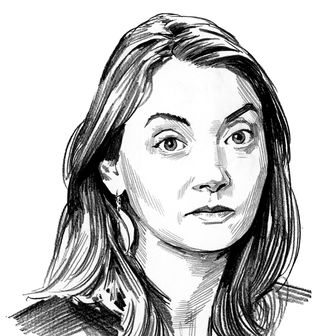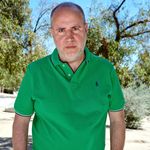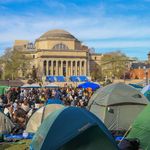
You’re never that far from an advertisement at the Shed, the enormous culture building that sits at the top of the High Line. For one thing, even when you’re technically inside it, you’re still aware it’s part of a shopping center. The Shed’s McCourt venue is a huge glass box, a lobbylike plaza on the south end of Hudson Yards that can be covered when necessary by the Shed’s massive, telescoping shell. The glass walls mean the world is never shut out: Look in one direction and you see through to the buildings on 30th Street; look in another and you see the Shops at Hudson Yards. So although performances in the McCourt may want to turn your thoughts to higher things, all that mall signage outside stays forever visible. You try to ignore the bright SEPHORA sign, and you adjust your eyeline. Something else glows: WATCHES OF SWITZERLAND.
Of course, the Shed itself is an exercise in branding, an assertion of public-spiritedness. Article after article has been written about whether the mere presence of a theater complex can “artwash” the extractive nature of the Hudson Yards project. If people feel squeamish about giving tax breaks to a “billionaire’s fantasy city,” maybe they can soothe their stomachs by thinking of it as a new Lincoln Center? And it serves another purpose. There’s a penthouse available for $59 million in one of those towers — and it’s classier to pay that kind of cash to live above a cultural campus than in a mall.
The scale of the McCourt is immense — it’s as tall and cold as a Courtyard by Marriott — and performers immediately seem rootless, lost, tiny. Having spent the week at Open Call, the Shed’s free performance series, I can say that its liminal weirdness has not been lessened by the pandemic. This year, Open Call is also sort of a lobby: It’s a threshold offering, a preparatory series before the real season. Not coincidentally, it’s full of young, diverse, often queer or trans artists presenting free performances. They’re in the building, sure, but the desk hasn’t issued them a key.
In three days, I saw four shows: Emily Waters’s Look Back at It, Nazareth Hassan’s Untitled (1–5), Rachika Nayar’s Our Hands Against the Dusk, and AnAkA’s AKTIV8 Archive Portal. The unspoken struggle between the punishing venue and the productions continued through all four. Nayar’s Dusk came closest to winning the argument — she obliterated our sense of the space with an almost impenetrable cloud of stage smoke — and made for a spectacular collision of artistry and moment. Others in the group were not so resilient.
In Look Back at It, Waters blends choreography, autobiographical storytelling, and film, all in service of their apotheosis. Sometimes playing a pastor or their own grandmother, Waters swears to their power, telling us about their experiences in storms — a hailstorm at age 4, a thunderstorm when they were 20 — and intensifies these events with poetic exaggeration. Two fellow hierophants sometimes come out to embrace them, or offer little church-lady murmurs of praise or movement. (The title is both a command to consider the ancestors and to dance — twerking ensues.) Even by the gentler standards of ritual, Look Back at It was underprepared. There can be beauty in the deliberately unpolished and unrehearsed, but poorly shot videos of performers standing cold on a New York beach, making vague and portentous gestures to the ocean, were accidentally awkward rather than defiantly rough.
A more tightly woven work of movement and self-expression, writer Nazareth Hassan’s Untitled (1-5) used the entire space, setting six dancers prowling through the center of the room, often in duos. For long sequences, pairs of performers simply sauntered back and forth past each other, like a gallery of Foucault pendulums, swinging and turning and swinging again. A later sequence involved the company standing at microphones intoning lines like “I failed at watching love and basketball” while the text is interrupted by other cries. Hassan’s writing is full of wicked humor (“I failed to trust my emotional landscape!”), and that sly knife lets you know that his other sections — even the unremarkable walking choreography — had their own edge. I came to think of these long pacing periods as the company scoring its presence into the Shed’s paving-stone floor.
That same night, I saw Nayar’s concert, and it started late partially because the hardworking fog machines had to fill up the gigantic room with smoke. It worked, though: We were drifting inside a fogbank, a hotbox, a cloud. Nayar’s blissed-out music was its own kind of fog, an envelope of hypnotic synthesizer dreamsound. Nayar played her ambient set (on a laptop) accompanied by a film shown on a high screen behind her. Sometimes blue neon lights would judder along to her beat, but mostly the images (shot by Frances Arpaia) were smeary, underwater, car-window dreams. When Nayar finished, our nerves still ringing with indescribable sounds, she thanked us — but the smoke didn’t clear, and we never saw her face. If it hadn’t been for that Sephora sign and those &#%!-ing Watches of Switzerland, we could have been in heaven.
AnAkA’s show very much wanted us in the same holy headspace — she entered burning imphepho, and an accompanying dancer moved through the seats, waving fronds and blessing us. But this work, like Waters’s, seemed to still be in its assemblage phase. On variously scattered screens, AnAkA showed documentary footage she has been shooting for years, often beautiful fragments: an artist in South Africa, sacred dancers in Mexico, boys on a beach somewhere. She accompanied it with her own unconfidently pitched singing, which lent the whole event an absurd tinge. The show’s spiritual tone faltered again when she and the circus artist India Sky Davis started pole dancing. Here, the space seemed at fault because their athletic grace was worthy of reverential attention. But the fog from the night before had cleared, and their isolation in that huge, ugly place turned the sublimity of their offering into the ridiculous.
There was one constant in all four works: an approach to art as a restorative ritual. It’s not just Open Call; there’s a vogue right now in performance for this kind of soi-disant religious ceremony. (At Astor Place recently, I saw folks setting up a DIY meditation labyrinth explicitly for Black healing; the ceremony-play What to Send Up When It Goes Down opens June 20 at BAM.) In their welcome letter, chief curator Emma Enderby, chief civic program officer Tamara McCaw, and director of civic programs Solana Chehtman remark on this trend, writing that “the impact of the pandemic, along with the hope and newness of being together in space once again” inspired the artists to turn, as one, to ritual and service.
As part of a gratitude practice, it’s important to lift up what should be praised. The curators cast wide for Open Call and found some vivid talents in their net; the technicians took what care they could to make an inhospitable venue seem warm. And I was glad, deeply glad, to see folks lining up to get into a show again. But there’s something slippery and unaccountable about Open Call, in that the Shed doesn’t need to place its reputation behind the work it’s presenting here. What I saw was of widely varying quality, some pieces frankly unready for (and ill served by) presentation. So I will hold my shouts of thanks for when the Shed invests more deeply in these artists and puts them in spaces that don’t fight them at every step. We’ll learn a lot from the rolling announcements of the Shed’s official season, which should come soon. Black and queer and brown and trans emerging artists have certainly found their place in Open Call. Will that programming ethos continue when we move into the more formal spaces and the venue starts charging for seats? Will the Call lead to Welcome? It shouldn’t take long for the fog to clear — and we’ll see.





